Part 1 of this 2-part series introduces and uses Alibaba Cloud ACK One to create a hybrid cloud/multi-cloud environment.
The Japanese market is a highly competitive marketplace for cloud infrastructure vendors, but nearly 30% of the Japanese domestic market is still on-premises.
Here are some what-ifs:
These what-ifs sound like pipe dreams, but several products or services have already made them a reality. Alibaba Cloud ACK One is one of those services that makes the what-ifs above a reality. This article introduces ACK One.
In this article, the definition of hybrid/multi-cloud refers to "to combine multiple public clouds and on-premises networks to operate them as a centralized service infrastructure (common infrastructure)."
Why did the idea of hybrid cloud/multi-cloud emerge? Answers to this question vary. This article introduces the interpretation of the writer.
The company had a previous contract with Google Workspace that limited other options.
Theories vary, but for now, it is also true that the hybrid/multi-cloud solution was created to solve various issues related to cloud and on-premises deployment.
There are various hybrid cloud/multi-cloud approaches that can be generally classified into two types:
1) Network-Based Hybrid/Multi-Cloud
SoftBank offers a network service called SD-WAN. You can use the service to achieve hybrid cloud/multi-cloud.
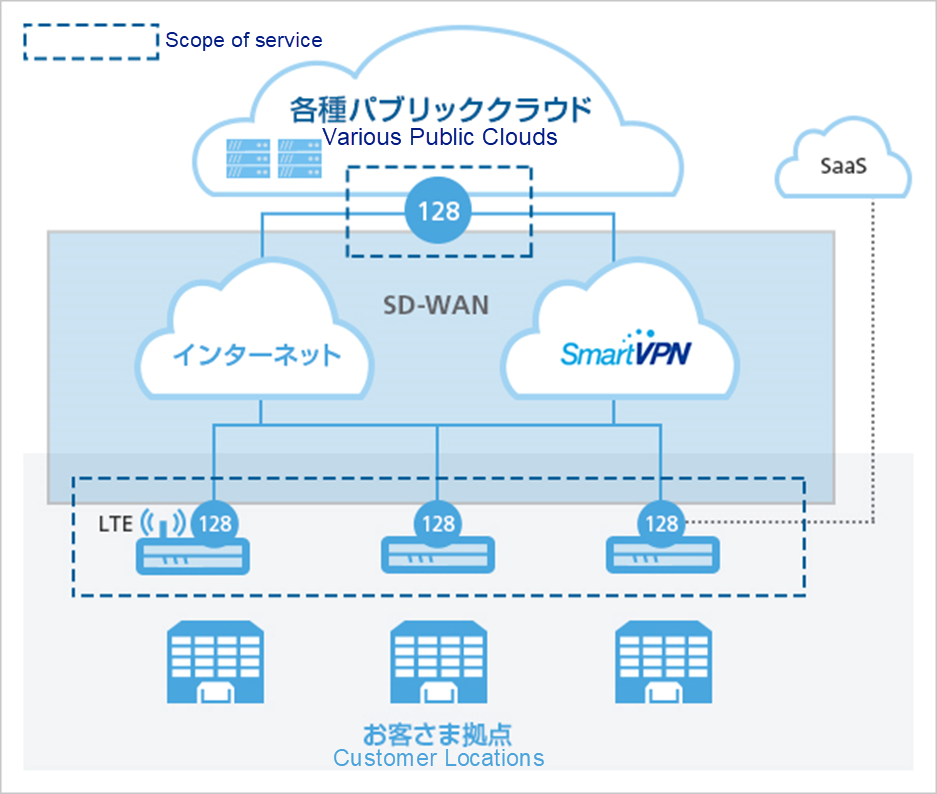
SoftBank also offers the OnePort network service. This service allows you to seamlessly connect on-premises networks or data centers to public clouds.
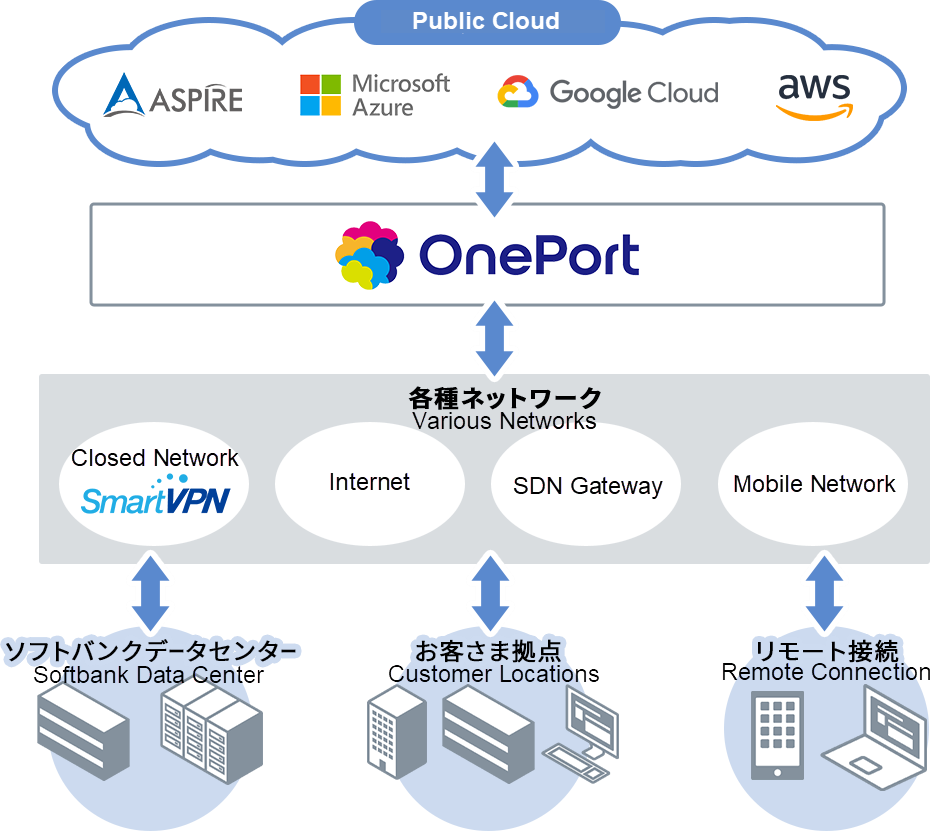
One approach is to connect heterogeneous clouds or connect clouds and on-premises networks using the network services (such as SD-WAN or OnePort) mentioned above. This approach connects and deploys each infrastructure and system completed in each environment.
2) System Infrastructure-Based Hybrid/Multi-Cloud Requirements
The section above introduces an approach where each infrastructure and system is connected using a network service. However, this approach requires various tasks in each environment, resulting in O&M costs and learning costs. Due to the ununified operating environments, configuration and setting cannot be automated. This means it is not so productive. In this case, you can use another approach to deploy and run applications in different environments with the same configuration and conditions. This approach is for Alibaba Cloud Container Service for Kubernetes (ACK).
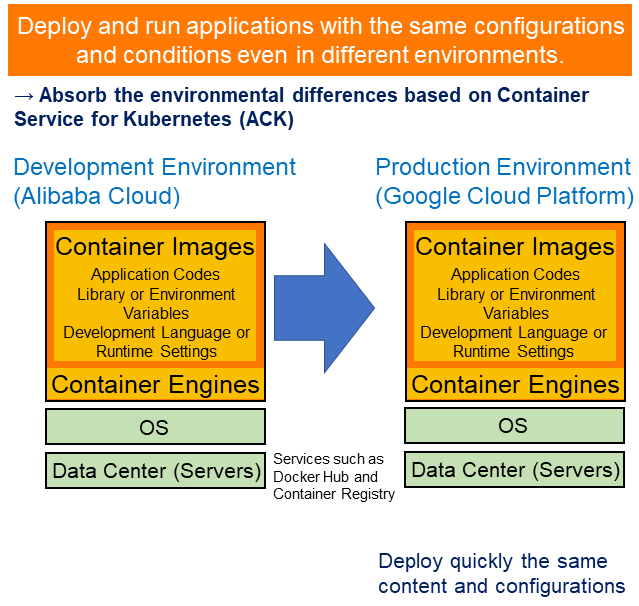
With Kubernetes, you can operate different clouds and on-premises environments using common procedures. This means Kubernetes can prevent development and operations from getting complicated by absorbing the differences between cloud and on-premise environments. How can we connect multiple underlying infrastructures for Kubernetes that exist in different environments to consistently support Kubernetes and achieve fully managed operations? The answer is to use container management platforms that support multiple environments. This article introduces one of the container management platforms, ACK One.
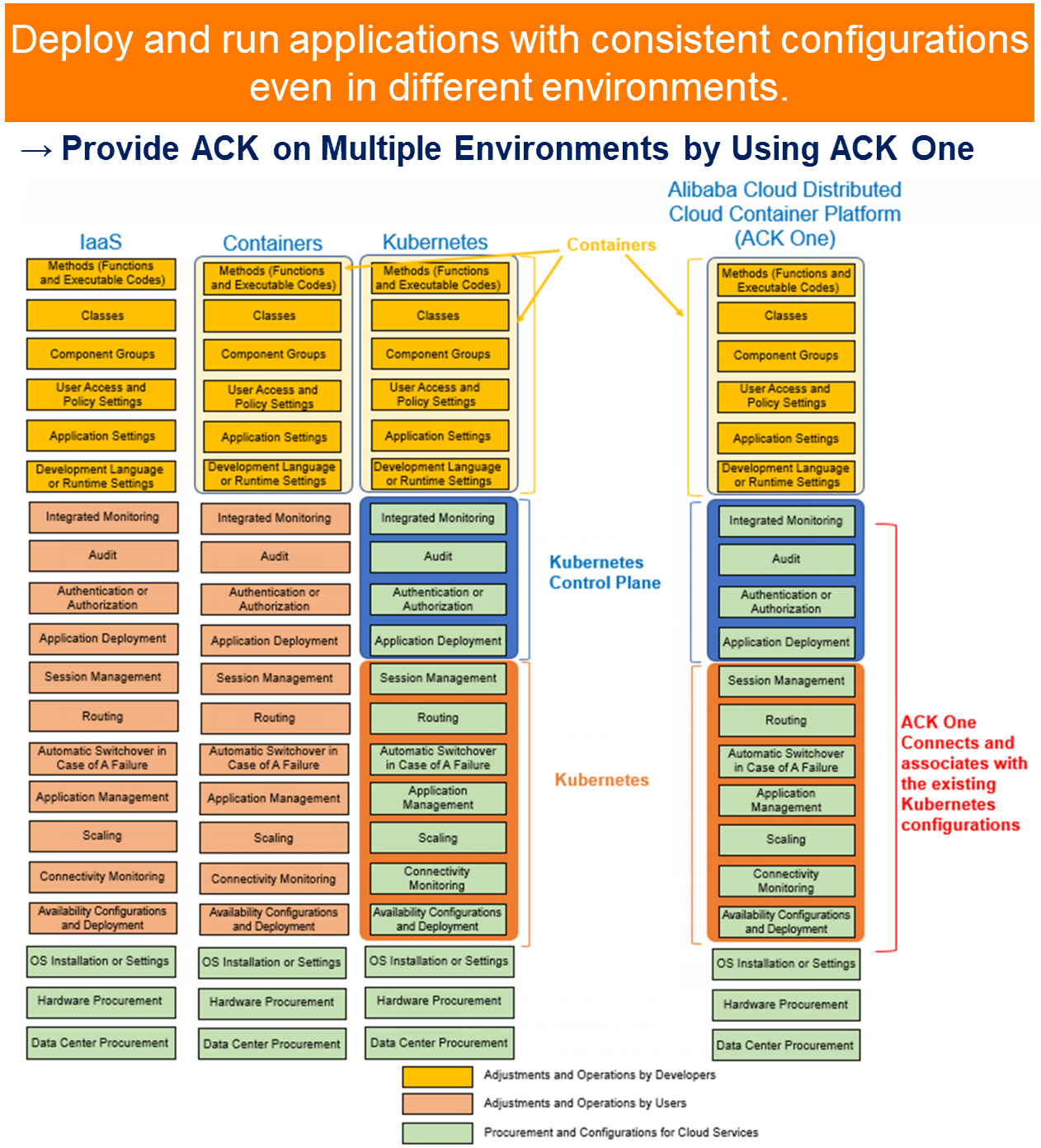
ACK One is a distributed cloud container platform based on the fully-managed Kubernetes ACK. ACK One offers a hybrid/multi-cloud environment, providing a consistent application environment and boundary-less computing environment.
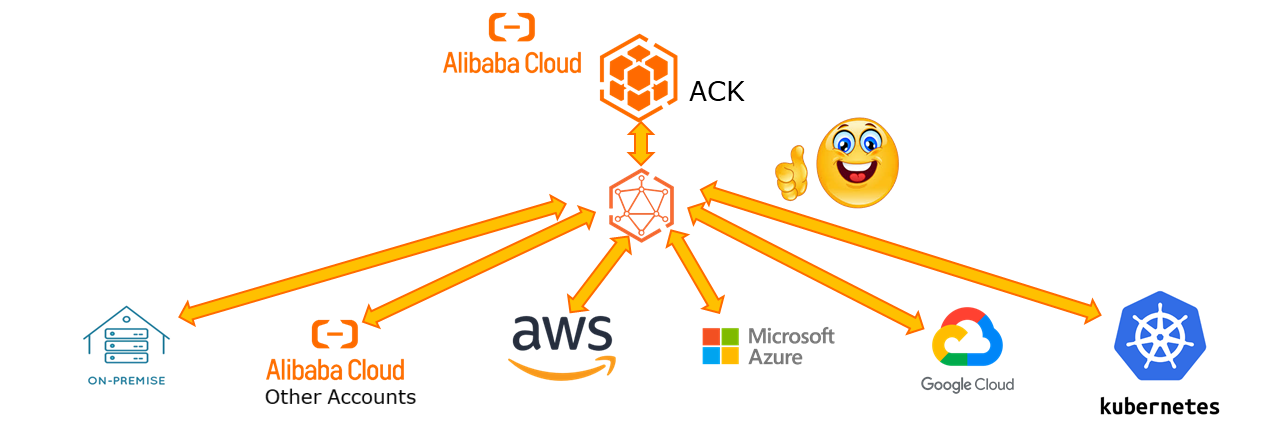
Kubernetes allows you to operate ACK One based on the fully managed Alibaba Cloud ACK (even on other clouds or on-premises environments) by simply registering the Kubernetes clusters in ACK One.

The ACK One service has the following features:
ACK One allows you to manage Kubernetes clusters deployed on the cloud, at the edge, or in data centers in a centralized manner. This ensures a consistent user experience when you manage cloud-native applications in different environments based on the Alibaba Cloud standard best practices. Also, you can implement security policies and cost-saving plans in a centralized manner.
ACK One allows you to manage the scheduling and distribution of jobs and job quotas for different tenants in multi-environment scenarios in a centralized manner. This improves resource utilization, enables data exchange between heterogeneous data sources in different regions, and accelerates AI computing and big data computing.
ACK One allows you to back up, restore, and migrate data. This enables cross-region cluster redundancy and ensures service continuity based on an active-active application architecture.
ACK One provides security policies for applications in hybrid cloud and multi-cluster scenarios. ACK One performs inspections to detect configuration risks and security vulnerabilities.
ACK One provides a distributed application delivery system that allows you to deploy applications across regions and clusters. This way, you can access the required applications from the closest access point in all regions.
ACK One allows you to manage north-south and east-west traffic in multi-cluster and multi-region scenarios based on the Alibaba Cloud standard best practices. Also, ACK One offers the Alibaba Cloud Service Mesh (ASM) module to manage the traffic of microservices. This feature is compatible with Istio.
This feature provides Alibaba Cloud services and cloud-native components validated by ACK One. You can deploy the services and components to a region or cluster with a few clicks.
As of October 28, 2022, ACK One is available in the following four regions: China (Hong Kong), Singapore, Indonesia (Jakarta), and Japan (Tokyo).
The multi-cluster management feature of ACK One supports multiple master instances. ACK One allows you to centrally manage Kubernetes clusters deployed in different environments (such as AWS, GCP, on-premises, and Alibaba Cloud accounts(.
After registering external Kubernetes clusters with ACK One, you can perform observability operations on external Kubernetes clusters with services (such as Alibaba Cloud Log Service, Application Real-Time Monitoring Service (ARMS), Prometheus, and CloudMonitor). Such observability enables load monitoring and event notification. Furthermore, in the event of an emergency, you can promptly and closely investigate why it happened and link it to your next action.
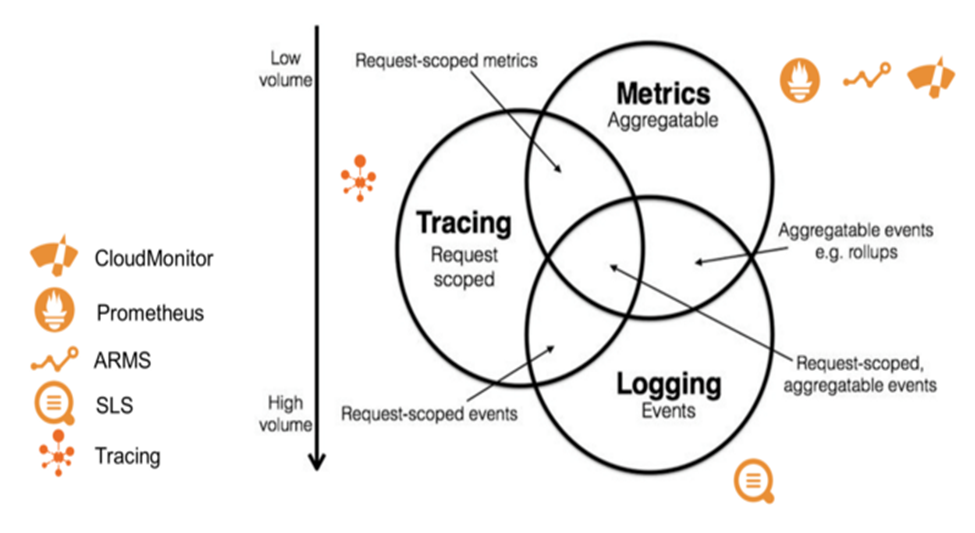
ACK One allows you to monitor and manage the costs of all clusters (including external Kubernetes clusters based on ARMS Prometheus in real time) and make the consumed resources visible.
In summary, ACK One can provide unified management, control, and operation of all workloads and visualize workload monitoring and costs, focusing on hybrid cloud and multi-cloud connectivity.
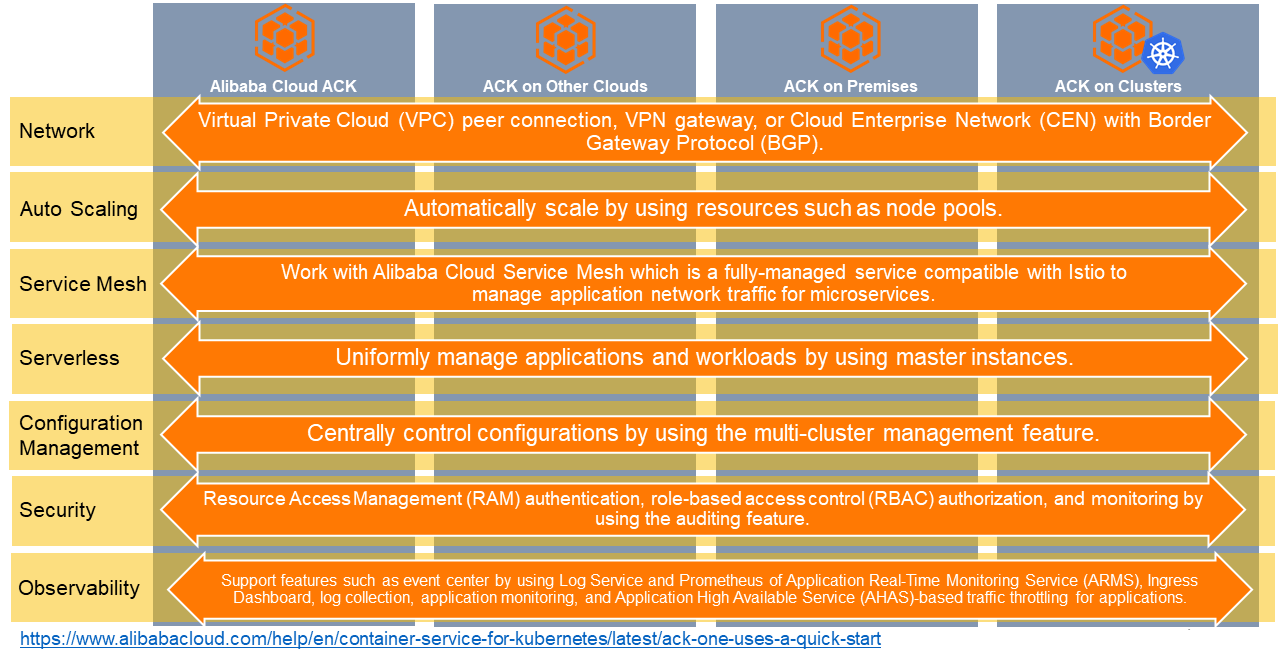
A frequently asked question – Does the hybrid cloud/multi-cloud approach only support network connections?
As the writer mentioned above, various issues cannot be solved by simple network connections and transmission between different environments. For example, after network connection and transmission between different environments, it is difficult to operate and monitor each different environment, adjust scaling, and manage costs. You can use ACK One to solve this problem.

Several different environments must be separately operated. Learning costs and O&M costs that cannot be solved by network connectivity alone
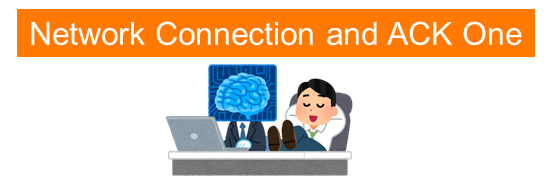
The observability feature allows you to perform O&M with only one interface.
ACK One enables unified control, operation, monitoring, and management of different environments, auto scaling, automatic failover, automatic backup, and cost visualization. This is a significant advantage.
ACK One can provide a wide variety of solutions. The following case is an example.
Let’s suppose the service you are using is on-premise and a huge monolithic service. When you use this service, you may encounter problems, such as scaling is difficult, development speed slows down depending on the business, even if you want to take on new initiatives (such as machine learning), service separation is difficult and incurs sunk costs, and you want to build an analytics infrastructure, but cannot afford it.

In this case, you can use ACK One and ACK to solve these problems.
Perform the following steps:
Step 1: Deploy Kubernetes as a container infrastructure in an on-premise environment. Convert the existing service infrastructure to a container image using Dockerfile and upload the deployment.yaml file to the Kubernetes cluster when you prepare the deployment.yaml file. Kubernetes is OSS and free of charge.
Step 2: Prepare your Alibaba Cloud account, fully managed Alibaba Cloud ACK, and ACK One.
Step 3: If the on-premises and Alibaba Cloud resources are connected using the VPN Gateway or Cloud Enterprise Network (CEN) in advance, register the on-premises Kubernetes cluster with ACK One. This allows Alibaba Cloud to manage the on-premise Kubernetes cluster.
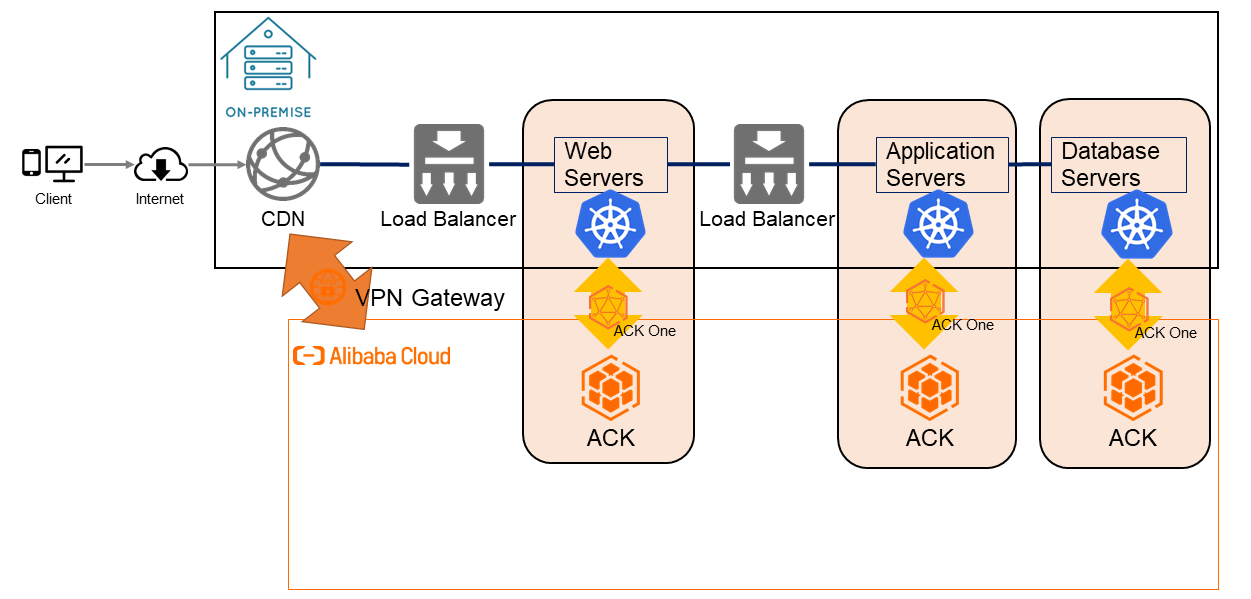
Step 4: Now, that Alibaba Cloud ACK and the on-premise Kubernetes cluster can be inter-managed and operated with AMC. AMC is a kubectl command line tool developed by Alibaba. The following content describes the advantages of the tool.
The web server tier uses the ACK One feature to automatically scale the pods and specifications of the mutual Kubernetes clusters based on user workloads, thereby reducing the cost of equipment upgrades as workloads increase or decrease.
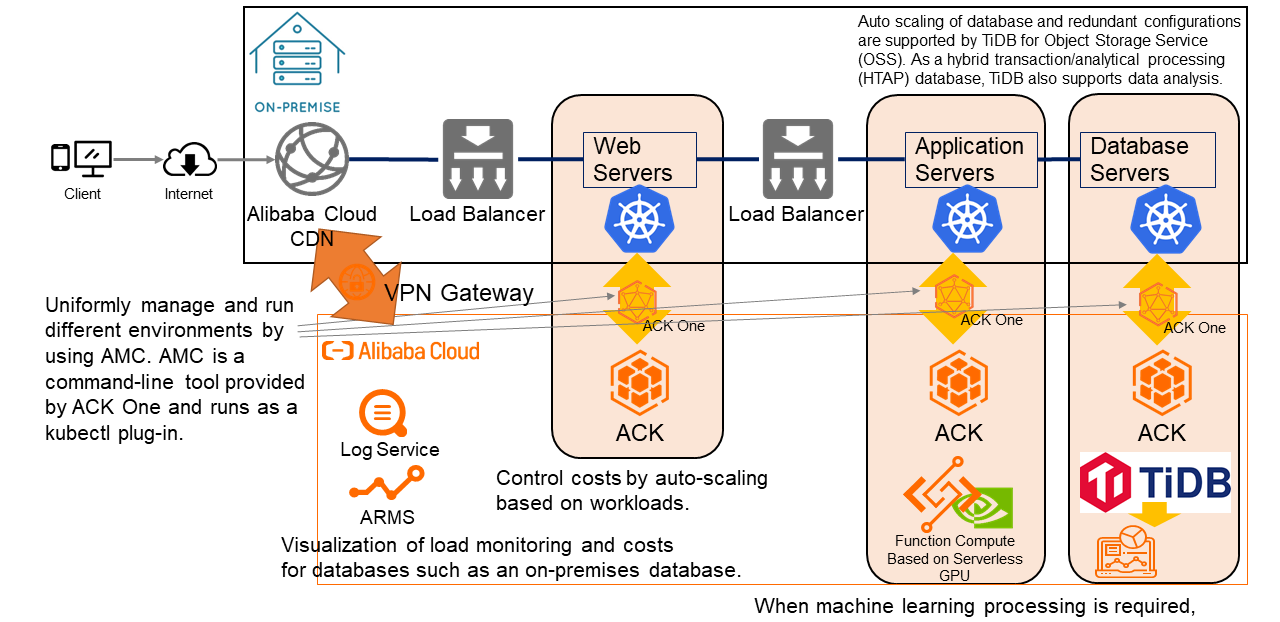
Additional cases ACK One can solve are introduced in Part 2 of this series. You can refer to Part 2 based on your business requirements.
Alibaba Cloud ACK One can link any Kubernetes platform and can control, operate, monitor, and manage several different environments in a unified manner. In addition, it provides features (such as auto scaling) across different environments while maintaining resource balance, automatic failover, automatic backups, and cost visualization and offering a variety of new options. ACK One is available and for free during the public preview, so please try it if you are interested. You can create a hybrid cloud/multi-cloud environment in the console with a few clicks.
Start Hybrid Cloud and Multi-Cloud with Alibaba Cloud ACK One [Part Two]:
https://www.alibabacloud.com/blog/start-hybrid-cloud-and-multi-cloud-with-alibaba-cloud-ack-one-part-two_599690
This article has been translated from SoftBank.
https://www.softbank.jp/biz/blog/cloud-technology/articles/202211/ack-one-part1/
Use the Babelfish Feature of Alibaba Cloud ApsaraDB for PostgreSQL to Serve as the SQL Server
Start Hybrid Cloud and Multi-Cloud with Alibaba Cloud ACK One [Part Two]

9 posts | 0 followers
FollowHironobu Ohara - February 3, 2023
Hironobu Ohara - May 18, 2023
Alibaba Clouder - March 2, 2021
Alibaba Cloud Community - February 3, 2023
Alibaba Container Service - November 13, 2019
Hironobu Ohara - April 5, 2023

9 posts | 0 followers
Follow Function Compute
Function Compute
Alibaba Cloud Function Compute is a fully-managed event-driven compute service. It allows you to focus on writing and uploading code without the need to manage infrastructure such as servers.
Learn More Hybrid Cloud Solution
Hybrid Cloud Solution
Highly reliable and secure deployment solutions for enterprises to fully experience the unique benefits of the hybrid cloud
Learn More Elastic High Performance Computing Solution
Elastic High Performance Computing Solution
High Performance Computing (HPC) and AI technology helps scientific research institutions to perform viral gene sequencing, conduct new drug research and development, and shorten the research and development cycle.
Learn More Hybrid Cloud Storage
Hybrid Cloud Storage
A cost-effective, efficient and easy-to-manage hybrid cloud storage solution.
Learn MoreMore Posts by Hironobu Ohara